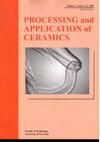Hydrothermally synthesis and characterization of HAp and Zr-doped HAp nanoparticles from bovine bone and zircon for photodynamic therapy
IF 0.8
4区 材料科学
Q3 MATERIALS SCIENCE, CERAMICS
引用次数: 6
Abstract
HAp and Zr-doped HAp nanoparticles were synthesized from bovine bone and local zircon material by using the hydrothermal method. XRD analysis showed that the HAp and Zr-doped HAp nanoparticles had hexagonal structure with a crystallite size of 20-36 nm and the lattice constants a = 9.8-9.9? and c = 6.5-6.8 ?. XRD data also showed that up to 20 at.% of Zr can be accommodated in HAp crystal structure. The lattice constant and cell volume decreased with increasing Zr concentration. FTIR data confirmed that the majority of functional groups that exist on the surface of the HAp and Zr-doped HAp nanoparticles were the hydroxyl and phosphate groups. Suspensions with the HAp and Zr-doped HAp nanoparticles prepared using citric acid as dispersant were stable with zeta potential between ?31 and ?35mV at pH = 7. Reactive oxygen species are generated on the produced HAp and Zr-doped Hap nanoparticles and confirm their potential for application in photodynamic therapy.光动力治疗用牛骨和锆石水热合成HAp和zr掺杂HAp纳米颗粒及其表征
以牛骨和局部锆石材料为原料,采用水热法制备了HAp和zr掺杂HAp纳米颗粒。XRD分析表明,HAp和zr掺杂的HAp纳米颗粒具有六方结构,晶粒尺寸为20 ~ 36 nm,晶格常数a = 9.8 ~ 9.9?c = 6.5-6.8 ?XRD数据也显示出高达20 at。在HAp晶体结构中可以容纳%的Zr。随着Zr浓度的增加,晶格常数和胞体体积减小。FTIR数据证实,HAp和zr掺杂的HAp纳米颗粒表面存在的大部分官能团是羟基和磷酸基团。以柠檬酸为分散剂制备的HAp和zr掺杂HAp纳米粒子悬浮液在pH = 7时具有稳定的zeta电位,在- 31 ~ - 35mV之间。在制备的HAp和掺杂zr的HAp纳米颗粒上产生活性氧,证实了它们在光动力治疗中的应用潜力。
本文章由计算机程序翻译,如有差异,请以英文原文为准。
求助全文
约1分钟内获得全文
求助全文
来源期刊

Processing and Application of Ceramics
MATERIALS SCIENCE, CERAMICS-
CiteScore
1.90
自引率
9.10%
发文量
14
审稿时长
10 weeks
期刊介绍:
Information not localized
 求助内容:
求助内容: 应助结果提醒方式:
应助结果提醒方式:


